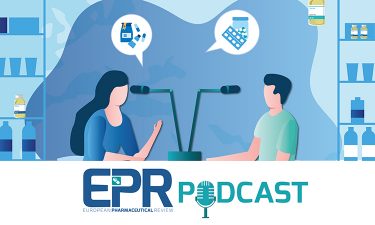
European Pharmaceutical Review podcast
EPR Podcast Episode 17 – Antimicrobial Resistance – Boumediene Soufi, Sandoz

Antimicrobial resistance (AMR) is a growing concern worldwide and is recognised as one of the leading health challenges by the World Health Organization (WHO).1 With drug resistant infections contributing to nearly 5 million deaths every year2 and costing the European Union (EU) an estimated €1.5 billion per year3 in healthcare costs and productivity losses, AMR is both a scientific and economic issue.
In this episode, Dr Boumediene Soufi, Head of Antimicrobial Resistance at Sandoz, discusses the challenge of AMR and some of the actions being taken by Sandoz and the wider pharmaceutical industry to address this issue.
What is antimicrobial resistance and why is it a concern today?
Boumediene (‘Bo’) starts by explaining what antimicrobial resistance is and the main factors that contribute to AMR. He also highlights the key virulent antibiotic resistant pathogens that are of concern today.
“Antimicrobial resistance is causing an unprecedented global public health threat,” Bo says.
He reflects on how antibiotics “brought about a whole new level of healthcare and quality of living,” describing them as the “backbone” of modern medicine.
A 2021 report published in the Lancet2 estimated, based on 2019 data, that there are 1.3 million deaths worldwide every year that can be directly attributed to AMR. Putting that in perspective, Bo explains “that means…drug resistant infections are killing more individuals than HIV or malaria.”
“It’s going to require a multi-sectoral, multi-collaborative effort to be able to address antimicrobial resistance,” Bo stresses.
“If we do not…[we could] be approaching what’s known as the post-antibiotic era,” he warns. The potential repercussions – risks to routine surgeries, as well as the economic burden – would be ‘astronomical.’
What are the main challenges related to AMR?

Boumediene Soufi holds the position of Global Head Antimicrobial Resistance at Sandoz.
There are two major challenges related to antimicrobial resistance: the scientific challenge and the economic challenge.
“From the scientific point of view…bacteria are evolving rapidly. It’s very difficult to predict how they are going to evolve their resistance patterns,” Bo explains.
Using antibiotics too much (over prescription), not having access to antibiotics or sub-optimal use (ie, not using the ideal antibiotic for a particular infection), also need to be addressed.
Another big issue is the lack of robust diagnostics for antimicrobial resistance. “We need surveillance programmes to understand the biggest problems of resistance, and then to respond to them in the correct way,” Bo states.
What action is the pharmaceutical industry taking to help prevent antimicrobial resistance?
“The first thing is to acknowledge the threat and to be able to respond,” says Bo. He believes this is being done already, with growing awareness that the issue of antimicrobial resistance needs to be addressed “very, very quickly.”
The industry response can be divided into two parts: action to develop innovative drugs and efforts focused on existing antibiotics.
“Of course, new antibiotics are a solution to the problem but I cannot stress enough, what we currently have is…of equal importance,” Bo says.
“Strong stewardship programmes are absolutely needed to make sure that [we use] the right drug for the right bug,” he adds. The WHO’s Access, Watch, Reserve (AWaRe) tool that helps support antibiotic monitoring and stewardship activities across sectors, is one mechanism assisting with this.
Another key effort is related to responsible access: “ensuring that — regardless of where a patient may be — they have access to the right drug.”
Looking to innovation, Bo highlights the importance of collaboration to support late stages of drug development. Initiatives such as the AMR Action Fund and the Global Antibiotic Research and Development Partnership both aim to help innovator companies overcome the technical and funding barriers faced during late-stage antibiotic development.
On the generic side, Sandoz follows a “balanced approach” addressing the four pillars established by the AMR Industry Alliance: Innovation; access; responsible use; and responsible manufacturing , Bo says.
Time to act
When asked why it’s important to act to tackle antimicrobial resistance now Bo concludes: “AMR is happening. Whether we like it or not, [AMR] is going to continue to happen based on the ability of bacteria to constantly mutate, but we can curb it significantly.”
“The most important thing is to recognise that it’s not too late…The next thing we need to do is realise that in order to curb AMR, it is going to require collaboration across multiple sectors. That’s what needs to happen in the next five years.”
To learn more about recent efforts to address antimicrobial resistance, listen to the full episode! Please join the conversation and leave your thoughts in the comments – we love hearing your feedback!
References
- Antimicrobial resistance [Internet]. Who.int. 2022 [cited 1 November 2022]. Available from: https://www.who.int/news-room/fact-sheets/detail/antimicrobial-resistance
- Murray C, Ikuta K, Sharara F, et al. Global burden of bacterial antimicrobial resistance in 2019: a systematic analysis. The Lancet. 2022;399(10325):629-655.
- EU Action on Antimicrobial Resistance. European Comission. 2022. [cite 1 November 2022]. Available from: https://health.ec.europa.eu/antimicrobial-resistance/eu-action-antimicrobial-resistance_en
The post <em>EPR</em> Podcast Episode 17 – Antimicrobial Resistance – Boumediene Soufi, Sandoz appeared first on European Pharmaceutical Review.